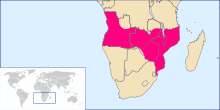Chinde is a town of Mozambique, and a port for the Zambezi valley. It is located on the Chinde River, and is an important fishing center. It exports copra and sugar, and had a population of 16,500 in 1980. Chinde lies in Chinde District of Zambezia Province.
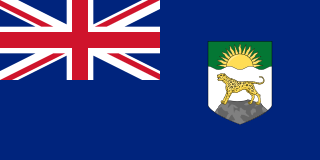
Nyasaland was a British protectorate located in Africa that was established in 1907 when the former British Central Africa Protectorate changed its name. Between 1953 and 1963, Nyasaland was part of the Federation of Rhodesia and Nyasaland. After the Federation was dissolved, Nyasaland became independent from Britain on 6 July 1964 and was renamed Malawi.

The British Central Africa Protectorate (BCA) was a British protectorate proclaimed in 1889 and ratified in 1891 that occupied the same area as present-day Malawi: it was renamed Nyasaland in 1907. British interest in the area arose from visits made by David Livingstone from 1858 onward during his exploration of the Zambezi area. This encouraged missionary activity that started in the 1860s, undertaken by the Universities' Mission to Central Africa, the Church of Scotland and the Free Church of Scotland, and which was followed by a small number of settlers. The Portuguese government attempted to claim much of the area in which the missionaries and settlers operated, but this was disputed by the British government. To forestall a Portuguese expedition claiming effective occupation, a protectorate was proclaimed, first over the south of this area, then over the whole of it in 1889. After negotiations with the Portuguese and German governments on its boundaries, the protectorate was formally ratified by the British government in May 1891.
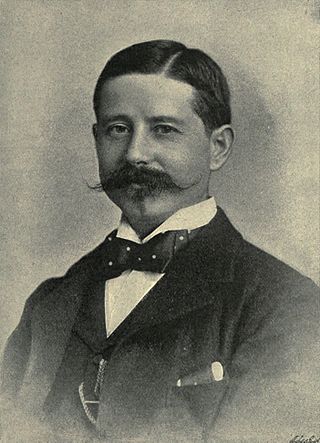
Sir Henry Hamilton Johnston was a British explorer, botanist, artist, colonial administrator, and linguist who travelled widely across Africa to speak some of the languages spoken by people on that continent. He published 40 books on subjects related to the continent of Africa and was one of the key players in the Scramble for Africa that occurred at the end of the 19th century.

The British South Africa Company was chartered in 1889 following the amalgamation of Cecil Rhodes' Central Search Association and the London-based Exploring Company Ltd, which had originally competed to capitalize on the expected mineral wealth of Mashonaland but united because of common economic interests and to secure British government backing. The company received a Royal Charter modelled on that of the British East India Company. Its first directors included The 2nd Duke of Abercorn, Rhodes himself, and the South African financier Alfred Beit. Rhodes hoped BSAC would promote colonisation and economic exploitation across much of south-central Africa, as part of the "Scramble for Africa". However, his main focus was south of the Zambezi, in Mashonaland and the coastal areas to its east, from which he believed the Portuguese could be removed by payment or force, and in the Transvaal, which he hoped would return to British control.
The African Lakes Corporation plc was a British company originally set-up in 1877 by Scottish businessmen to co-operate with Presbyterian missions in what is now Malawi. Despite its original connections with the Free Church of Scotland, it operated its businesses in Africa on a commercial rather than a philanthropic basis. It had political ambitions in the 1880s to control part of Central Africa and engaged in armed conflict with Swahili traders. Its businesses in the colonial era included water transport on the lakes and rivers of Central Africa, wholesale and retail trading including the operation of general stores, labour recruitment, landowning and later an automotive business. The company later diversified, but suffered an economic decline in the 1990s and was liquidated in 2007. One of the last directors of the company kindly bought the records of the company and donated them to Glasgow University Archive Services, where they are still available for research.

Alexandre Alberto da Rocha de Serpa Pinto, Viscount of Serpa Pinto was a Portuguese explorer of southern Africa and a colonial administrator.
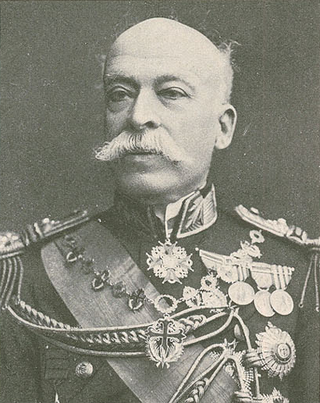
Hermenegildo de Brito Capelo (1841–1917) was a Portuguese officer in the Portuguese Navy and an explorer, who helped to chart territory between Angola and Mozambique that was unknown to Europeans in the 1870s and 1880s. Alongside Roberto Ivens, he is famous for being the first European to cross Central Africa from coast to coast between Angola and Mozambique.
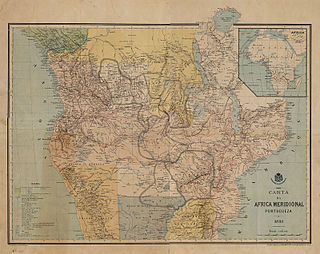
The Pink Map, also known in English as the Rose-Coloured Map, was a map prepared in 1885 to represent Portugal's claim of sovereignty over a land corridor connecting their colonies of Angola and Mozambique during the Scramble for Africa. The area claimed included most of what is currently Zimbabwe and large parts of modern Zambia and Malawi. In the first half of the 19th century, Portugal fully controlled only a few coastal towns in Angola and Mozambique. It also claimed suzerainty over other almost independent towns and nominally Portuguese subjects in the Zambezi valley, but could rarely enforce its claims; most of the territory now within Angola and Mozambique was entirely independent of Portuguese control. Between 1840 and 1869, Portugal expanded the area it controlled but felt threatened by the activities of other powers.

Sir Alfred Sharpe was Commissioner and Consul-General for the British Central Africa Protectorate and first Governor of Nyasaland.
Eugene Charles Albert Sharrer was a British subject by naturalisation but of German descent, who was a leading entrepreneur in what is now Malawi for around fifteen years between his arrival in 1888 and his departure. He rapidly built-up commercial operations including wholesale and retail trading, considerable holdings of land, cotton and coffee plantations and a fleet of steamers on the Zambezi and Shire rivers. Sharrer was prominent in pressure groups that represented the interests of European planters and their businesses to the colonial authorities, and was responsible for the development of the first railway in what had become the British Central Africa Protectorate, whose construction was agreed in 1902. In 1902, Sharrer consolidate all his business interests into the British Central Africa Company Ltd and became its principal shareholder Shortly after this he left British Central Africa permanently for London, although he retained his financial interests in the territory. Very little is known of his history before he arrived in Central Africa but he died in London during the First World War.
The Anglo-Portuguese Treaty of 1891 was an agreement between the United Kingdom and Portugal which fixed the boundaries between the British Central Africa Protectorate, and the territories administered by the British South Africa Company in Mashonaland and Matabeleland and North-Western Rhodesia and Portuguese Mozambique, and also between the British South Africa Company administered territories of North-Eastern Rhodesia, and Portuguese Angola.
John Buchanan (1855–1896), was a Scottish horticulturist who went to Central Africa, now Malawi, in 1876 as a lay member of the missionary party that established Blantyre Mission. Buchanan came to Central Africa as an ambitious artisan: his character was described as dour and devout but also as restlessly ambitious, and he saw in Central Africa a gateway to personal achievement. He started a mission farm on the site of Zomba, Malawi but was dismissed from the mission in 1881 for brutality. From being a disgraced missionary, Buchanan first became a very influential planter owning, with his brothers, extensive estates in Zomba District. He then achieved the highest position he could in the British administration as Acting British Consul to Central Africa from 1887 to 1891. In that capacity declared a protectorate over the Shire Highlands in 1889 to pre-empt a Portuguese expedition that intended to claim sovereignty over that region. In 1891, the Shire Highlands became part of the British Central Africa Protectorate. John Buchanan died at Chinde in Mozambique in March 1896 on his way to visit Scotland, and his estates were later acquired by the Blantyre and East Africa Ltd.

The history of rail transport in Malawi began shortly after the turn of the twentieth century.

The Shire Highlands Railway Company Ltd was a private railway company in colonial Nyasaland, incorporated in 1895 with the intention of constructing a railway from Blantyre to the effective head of navigation of the Shire River. After problems with routing and finance, a South African 3 ft 6 in gauge railway was constructed between 1903 and 1907, and extended in 1908 to a Nsanje, a distance of 113 miles (182 km) as water levels in the Shire River fell.
The Treaty of Windsor was a secret colonial declaration between the United Kingdom and Portugal in 1899. It was named after the earlier Treaty of Windsor (1386) though actually signed in London on 14 October 1899 by the British Prime Minister Lord Salisbury and the Portuguese ambassador Soveral.
The M'Bona Cult is a system of religious beliefs and rituals which is currently restricted to the most southerly parts of Malawi, but which probably extended more widely, both in other parts of Malawi and adjacent parts of Mozambique. The cult is found mainly among the local Mang'anja people and its former extent reflected that people's wider past distribution. It aims to secure abundant rains at the appropriate season through the making of propitiatory gifts at cult shrines, and includes rainmaking rituals in the event of drought. It has been related to a number of other territorial cults among the Maravi cluster of related African peoples which aim to secure the well-being of the people of a particular area secure from drought, floods or food shortages. The cult is believed to be a long established one, although estimates of how long it has existed are speculative, as the earliest definite record of its existence dates from 1862.
Chikunda, sometimes rendered as Achicunda, was the name given from the 18th century onwards to the slave-warriors of the Afro-Portuguese estates known as Prazos in Zambezia, Mozambique. They were used to defend the prazos and police their inhabitants. Many of the chikunda were originally chattel slaves, raised to the status of soldiers, traders or administrators of parts of the prazo as a client or unfree dependent.
The Makololo chiefs recognised by the governments of colonial Nyasaland and independent Malawi have their origin in a group of porters that David Livingstone brought from Barotseland in the 1850s to support his first Zambezi expedition that did not return to Barotseland but assisted Livingstone and British missionaries in the area of southern Malawi between 1859 and 1864. After the withdrawal of the Universities' Mission to Central Africa those Makololo remaining in the Shire valley used firearms provided by the Europeans to attract dependants seeking protection, to seize land and to establish a number of chieftainships. At the time that a British protectorate was established in 1891, there were seven Makololo chiefs of which six were recognised by the government. Five survived to be given local governmental powers in 1933, and these powers continued after Malawi became independent. Although called Makololo or Kololo, after the ruling group in Barotseland in the 1850s, the majority came from peoples subject to the Makololo who adopted the more prestigious name. As, regardless of their origin, they took wives from among the inhabitants of the Shire Valley, their modern descendants have little connection with the Kololo people apart from their name.
